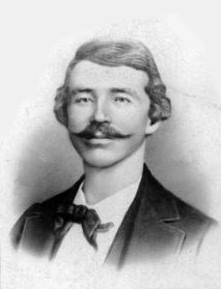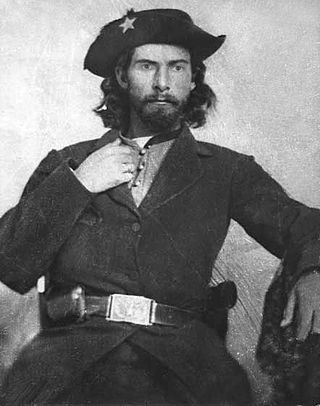Related Research Articles

Quantrill's Raiders were the best-known of the pro-Confederate partisan guerrillas who fought in the American Civil War. Their leader was William Quantrill and they included Jesse James and his brother Frank.

William Clarke Quantrill was a Confederate guerrilla leader during the American Civil War.

The Battle of Baxter Springs, more commonly known as the Baxter Springs Massacre, was a minor battle of the American Civil War fought on 6 October 1863, near the present-day town of Baxter Springs, Kansas.

William T. Anderson, known by the nickname "Bloody Bill" Anderson, was a soldier who was one of the deadliest and most notorious Confederate guerrilla leaders in the American Civil War. Anderson led a band of volunteer partisan raiders who targeted Union loyalists and federal soldiers in the states of Missouri and Kansas.

James G.Blunt was an American physician and abolitionist who rose to the rank of major general in the Union Army during the American Civil War. He was defeated by Quantrill's Raiders at the Battle of Baxter Springs in Kansas in 1863, but is considered to have served well the next year as a division commander during Price's Raid in Missouri.
The 3rd Wisconsin Cavalry Regiment was a volunteer cavalry regiment that served in the Union Army during the American Civil War.

The Battle of Honey Springs, also known as the Affair at Elk Creek, on July 17, 1863, was an American Civil War engagement and an important victory for Union forces in their efforts to gain control of the Indian Territory. It was the largest confrontation between Union and Confederate forces in the area that would eventually become Oklahoma. The engagement was also unique in the fact that white soldiers were the minority in both fighting forces. Native Americans made up a significant portion of each of the opposing armies and the Union force contained African-American units.
The trans-Mississippi theater of the American Civil War was the scene of the major military operations west of the Mississippi River. The area is often thought of as excluding the states and territories bordering the Pacific Ocean, which formed the Pacific coast theater of the American Civil War (1861–1865).
The Battle of Old Fort Wayne, also known as Maysville, Beattie's Prairie, or Beaty's Prairie, was an American Civil War battle on October 22, 1862, in Delaware County in what is now eastern Oklahoma.

At the outbreak of the American Civil War in April 1861, Kansas was the newest U.S. state, admitted just months earlier in January. The state had formally rejected slavery by popular vote and vowed to fight on the side of the Union, though ideological divisions with neighboring Missouri, a slave state, had led to violent conflict in previous years and persisted for the duration of the war.

During the American Civil War, most of what is now the U.S. state of Oklahoma was designated as the Indian Territory. It served as an unorganized region that had been set aside specifically for Native American tribes and was occupied mostly by tribes which had been removed from their ancestral lands in the Southeastern United States following the Indian Removal Act of 1830. As part of the Trans-Mississippi Theater, the Indian Territory was the scene of numerous skirmishes and seven officially recognized battles involving both Native American units allied with the Confederate States of America and Native Americans loyal to the United States government, as well as other Union and Confederate troops.
William Weer was a lawyer, attorney general for Kansas and an officer in the Union Army during the American Civil War. He is notable for his service in the Trans-Mississippi Theater early in the war and later for being dismissed from the army following a court-martial.
The 14th Kansas Cavalry Regiment was a cavalry regiment that served in the Union Army during the American Civil War.
Kansas has always been home to many forts and military posts.
On March 7, 1862, Confederate guerrillas under William C. Quantrill raided the small Kansas community of Aubry, southwest of Kansas City, Missouri, and just west of the Kansas-Missouri border. Three residents were killed in the raid and much property was carted away by the guerrillas.
In early May 1863 a temporary camp, Camp Hooker, was established at the site of what later became Baxter Springs, Kansas. This area was located in what was known as the Cherokee Strip (Kansas). In late May while the camp commander, Col. James M. Williams, was in Fort Scott, the troops moved the camp three blocks to the east to what is now Washington School Hill. The new camp, Camp Ben Butler (named after Maj. Gen. Benjamin Butler, was in a highly defendable position. It occupied a plateau that covered more than two square blocks. Only a small area to the south allowed easy access to camp. In fact, much of the surrounding area was practically impenetrable by men or horses.
Camp Hunter was established in June 1862 or a bit earlier at what is now Baxter Springs, Kansas. It was established by Union troops. At the same time Indian Home Guard regiments established a camp nearby on Little Five Mile Creek.
In June 1862 two Union camps were established in the vicinity of what is today Baxter Springs, Kansas. One was Camp Hunter, located in what is now the center of the town. The other was the Indian Home Guard Camp, located at Little Five Mile Creek, 1½ miles southeast of Camp Hunter.
Fort McKean is a fort located inside Kansas along the Kansas-Missouri border. On November 14, 1862, Company C of the 3rd Wisconsin Cavalry, led by Lieut. James B. Pond, established a camp at Morris Mills on Drywood Creek. It was fifteen miles southeast of Fort Scott. Sometime later this camp was given the name of Fort McKean. The post was probably on the Fort Scott-Fort Gibson Military Road, and many, including Pond, thought the post was inside Missouri. Throughout its history, Fort McKean was a small post, ranging in strength from 20 to 60 men. It is unknown what buildings or defenses were erected there.
The Van Buren raid occurred in Crawford County, Arkansas, on December 28, 1862, during the American Civil War. After defeating Confederate forces led by Major General Thomas C. Hindman at the Battle of Prairie Grove on December 7, 1862, Union forces under Brigadiers General James G. Blunt and Francis J. Herron prepared for a raid against the Confederate positions at Van Buren and Fort Smith. Disease, lack of supplies, and desertion had previously forced Hindman to begin withdrawing most of his force from the area. Setting out on December 27, the Union troops struck an outlying Confederate cavalry unit near Drippings Spring, north of Van Buren, on the morning of December 28. The Confederate cavalry fled to Van Buren, which was then overrun by Union troops.
References
- ↑ Woodbury F. Pride, The History of Fort Riley (n.p.: 1926), p. 46
- ↑ William E. Connelley, Quantrill and the Border Wars, New York: Pageant Book Co., 1956), 1956 ed., p. 422.
- ↑ Edited, Frank W. Blackmar, Kansas: a cyclopedia of state history, embracing events, institutions, industries, counties, cities, towns, prominent persons, etc. ... / with a supplementary volume devoted to selected personal history and reminiscence, Vol. 1 of 3, Chicago: Standard Pub. Co., 1912, p. 657
- ↑ "Chapter XIII: The History of Baxter Springs", History of Cherokee County, Kansas and representative citizens, Ed. and comp. by Nathaniel Thompson Allison, 1904
- ↑ Connelley, pp. 430,, 432-4.
- ↑ Hugh L. Thompson, "Baxter Springs as a Military Post—1862–1863," Kansas in the Civil War Battles and Campaigns, Vol. 3, pp. 32-4 (from the Kansas State Historical Society).